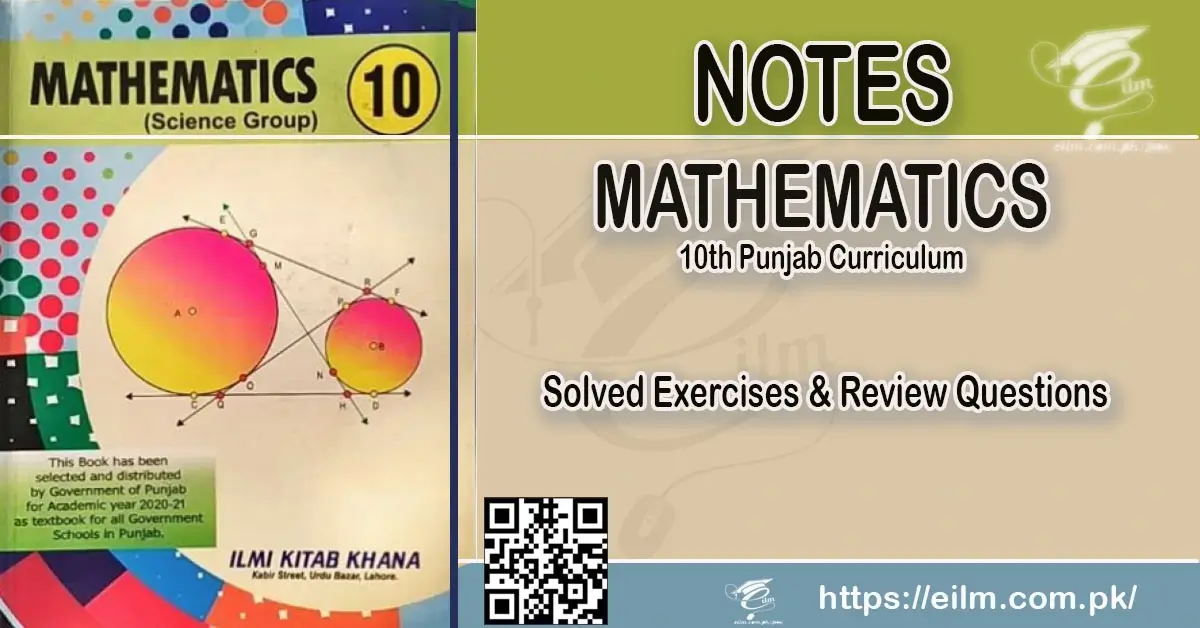Physics Chapter-12 Geometrical Optics Notes Latest Punjab Board
Geometrical Optics Notes Free PDF Download Punjab Curriculum
10th Physics Unit-12 Geometrical Optics Notes
“ Gaining knowledge ,is the first step to wisdom,Sharing it ,is the first step to Huminity”
Summary of Unit 12: Geometrical Optics
- When light travelling in a certain medium falls on the surface of another
medium, a part of it turns back in the same medium. This is called reflection of
light. There are two laws of reflection:
i. The incident ray, the reflected ray, and the normal all lie in the same plane.
ii. The angle of incidence is equal to the angle of reflection (i.e., i = r). - Like plane surfaces, spherical surfaces also reflect light satisfying the two
laws of reflection. - In mirrors, image formation takes place through reflection of light while in
lenses image is formed through refraction of light. - Power of a lens is defined as “the reciprocal of its focal length in metres”. Thus Power of a lens = P = 1 / focal length in metres. The SI unit of power of a lens is “Dioptre”,denoted by a symbol D. If f is expressed in metres so that 1 D = 1 m-1. Thus, 1 Dioptre is the power of a lens whose focal length is 1 metre.
- The bending of light from its straight path as it passes from one medium into another is called refraction.
- Refraction of light takes place under two laws called laws of refraction. These arestated as: i. The incident ray, the refracted ray, and the normal at the point of incidence all lie in the same plane. ii. The ratio of the sine of the angle of incidence ‘i’ to the sine of the angle of refraction‘r’ is always equal to a constant.
- The angle of incidence for which the angle of refraction becomes 90 is called critical angle. When the angle of incidence becomes larger than the critical angle, no refraction occurs. The entire light is reflected back into the denser medium. This is known as total internal reflection of light.
- A simple microscope, also known as a magnifying glass, is a convex lens which is used to produce magnified images of small objects.
- A compound microscope is used to investigate structure of small objects and has two converging lens, the objective and the eyepiece.
- Telescope is an optical instrument which is used to observe distant objects using lenses or mirrors. A telescope that uses two converging lenses is called refracting telescope. A telescope in which the objective lens is replaced by a concave mirror is called reflecting power telescope.
- The magnifying power is defined as “the ratio of the angle subtended by the image as seen through the optical device to that subtended by the object at the unaided eye”.
- The resolving power of an instrument is its ability to distinguish between two closely placed objects.
- The ability of the eye to change the focal length of its lens so as to form a clear imageof an object on its retina is called its power of accommodation.
- The disability of the eye to form distinct images of distant objects on its retina is known as nearsightedness. The nearsighted eye can be corrected with glass or contact lenses that use diverging lenses. Light rays from the distant objects will diverge by this lens before entering the eye.
- The disability of the eye to form distinct images of nearby objects on its retina is known as farsightedness. This defects can be corrected with the aid of a suitable converging lens. The lens refracts the light rays more towards the principal axis before they enter the eye.
Class 10th Notes Punjab Board


Join EILM.COM.PK Learning Program
A student’s also look the latest Posts,and go to Blog for the Latest Stories,
Discoveries, Fun Activities, Exam Tips, and more.









